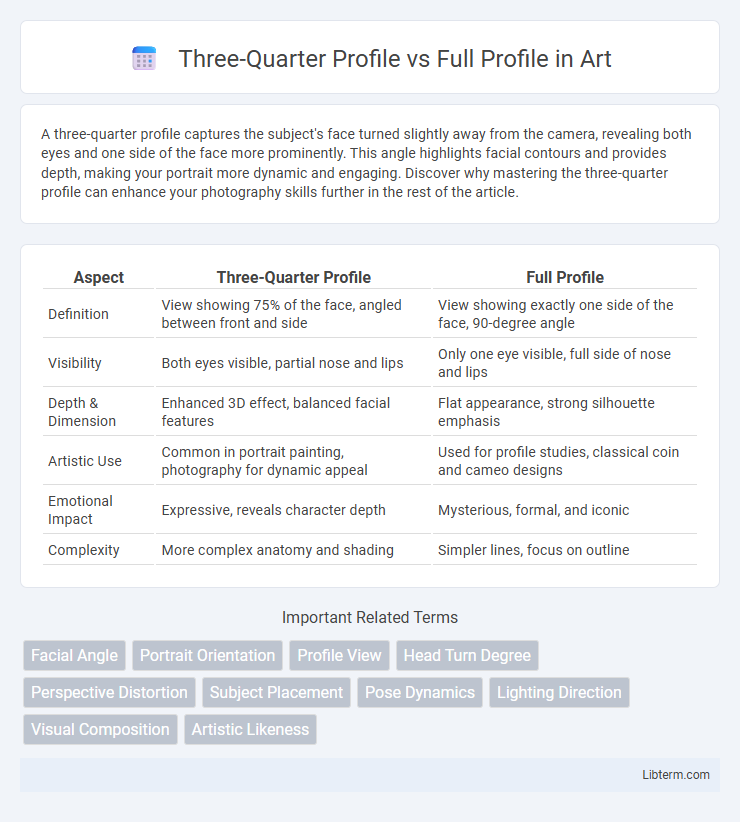A three-quarter profile captures the subject's face turned slightly away from the camera, revealing both eyes and one side of the face more prominently. This angle highlights facial contours and provides depth, making your portrait more dynamic and engaging. Discover why mastering the three-quarter profile can enhance your photography skills further in the rest of the article.
Table of Comparison
| Aspect | Three-Quarter Profile | Full Profile |
|---|---|---|
| Definition | View showing 75% of the face, angled between front and side | View showing exactly one side of the face, 90-degree angle |
| Visibility | Both eyes visible, partial nose and lips | Only one eye visible, full side of nose and lips |
| Depth & Dimension | Enhanced 3D effect, balanced facial features | Flat appearance, strong silhouette emphasis |
| Artistic Use | Common in portrait painting, photography for dynamic appeal | Used for profile studies, classical coin and cameo designs |
| Emotional Impact | Expressive, reveals character depth | Mysterious, formal, and iconic |
| Complexity | More complex anatomy and shading | Simpler lines, focus on outline |
Understanding Portrait Angles: An Introduction
Three-quarter profile captures the subject turned roughly 45 degrees from the camera, highlighting both facial features and depth, creating a dynamic and dimensional portrait. Full profile presents the subject's face entirely from the side, emphasizing the outline and silhouette, often conveying mystery or emphasis on shape. Understanding these portrait angles is essential for photographers and artists to manipulate mood, dimension, and character portrayal effectively.
What is a Three-Quarter Profile?
A three-quarter profile shows a subject's face turned slightly away from the camera, revealing more than just the side but less than a full frontal view, typically capturing about three-quarters of the face. This angle showcases the contour and depth of facial features, offering a balanced perspective between profile and full face imagery. Widely used in portrait photography and art, the three-quarter profile enhances the subject's expressions and personality by emphasizing both symmetry and dimension.
Defining Full Profile in Portrait Photography
Full profile in portrait photography captures the subject's face entirely from the side, highlighting the facial contour and silhouette without revealing the opposite side. This angle emphasizes features like the nose and lips, creating a strong, graphic representation of the subject's profile. Unlike the three-quarter profile which shows more facial detail, the full profile offers a distinct, minimalist perspective that isolates the outline and structure of the face.
Key Visual Differences Between the Two
Three-quarter profile features a view where the subject's face is turned halfway between a full-face view and a side profile, revealing more depth and dimension of facial features such as the nose, eyes, and cheekbones. Full profile captures the subject strictly from the side, highlighting the outline of the face, including the forehead, nose, lips, and chin in a linear silhouette. Key visual differences include the visibility of both eyes and more facial contours in three-quarter profile, whereas full profile emphasizes the subject's profile shape and distinct edges with a single eye view.
Artistic Implications: Three-Quarter vs Full Profile
The three-quarter profile captures more facial depth by revealing both eyes and part of the opposite cheek, enabling artists to convey emotion and dimensionality with greater subtlety and realism. Full profile limits visibility to one side of the face, emphasizing strong, clean lines and silhouette, often evoking a sense of mystery or focus on form rather than expression. Choosing between three-quarter and full profile fundamentally influences the artwork's narrative, mood, and viewer engagement by controlling the balance between detail and abstraction.
When to Use a Three-Quarter Profile
A three-quarter profile is ideal for portrait photography when the goal is to showcase facial features with depth and dimension, offering a natural and engaging appearance. This angle highlights cheekbones and jawlines while maintaining eye contact, making it perfect for professional headshots, fashion shoots, and artistic portraits. It is especially useful when a full profile feels too stark or when a frontal view lacks depth.
Ideal Scenarios for Full Profile Portraits
Full profile portraits are ideal for capturing strong facial features and emphasizing the subject's silhouette, often used in artistic photography and character studies. They work well in scenarios requiring a clear depiction of the subject's nose, jawline, and cheekbones, enhancing the visual storytelling aspect. In professional settings, such as identification photos or forensic documentation, full profile shots provide crucial side-view details.
Impact on Facial Features and Expression
Three-quarter profile captures a dynamic view of the face, highlighting the depth of facial features such as cheekbones and jawline while maintaining visibility of both eyes, which enhances emotional expression and dimension. Full profile offers a silhouette-like presentation, emphasizing the contour and structure of the nose and chin but limiting visibility of the eyes, thereby reducing the nuance of facial expressions. This contrast significantly affects portrait photography and character design, where the choice between three-quarter and full profile influences the perceived personality and emotional impact of the subject.
Common Mistakes to Avoid with Each Profile
When capturing a three-quarter profile, avoid positioning the subject too close to a full side angle, which can obscure facial features and reduce visual engagement. For full profiles, ensure proper lighting and focus to prevent flatness and loss of depth, as this angle can make the face appear two-dimensional. Both profiles require careful attention to head tilt and eye direction to maintain natural expression and viewer connection.
Choosing the Right Profile for Your Subject
Choosing the right profile for your subject depends on the desired mood and storytelling focus; a three-quarter profile captures depth and personality by showing both the front and side of the face, enhancing emotional connection. In contrast, a full profile emphasizes strong, sharp features and silhouette, ideal for highlighting facial structure or creating dramatic effect. Consider the subject's unique characteristics and the narrative you want to convey to select the profile that best complements their story.
Three-Quarter Profile Infographic

 libterm.com
libterm.com